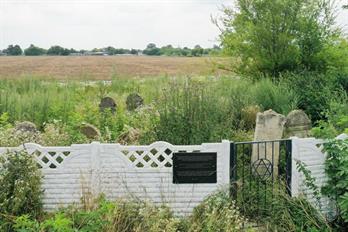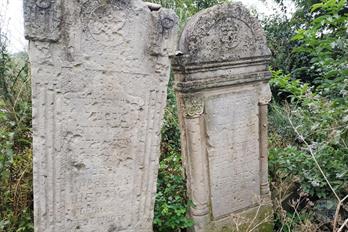Luzhany
Sources:
- Russian Jewish encyclopedia. Translated from Russian by Eugene Snaider
Photo:
- European Jewish Cemeteries Initiative. Luzhany Jewish Cemetery
- Russian Jewish encyclopedia. Translated from Russian by Eugene Snaider
Photo:
- European Jewish Cemeteries Initiative. Luzhany Jewish Cemetery
Luzhany (ukr. Лужани), urban-type settlement (since 1968), known from 1453. In the 16-18 centuries in Moldavian principality. In the 19 - beggining of the 20 centuries - in the province of Bukovina as part of the Austro-Hungarian Empire. In 1918-40 - as part of Romania, in 1940-91 - as part of Ukrainian SSR.
In 1930, 374 Jews lived in Luzhany (15.4%).
Jews have lived in Luzhany since the late 18th century. At the beginning of the 20th century a school acted with teaching in Hebrew.
Since 1920, Berl Teitelboim was a rabbi in Luzhany.
In 1925, a Jewish cemetery was founded, a plot of land for which was donated by one of the wealthy Jews. 2 synagogues acted, with each synagogue a library and 2 heders worked.
Since the beginning of the 1920s all trade (including grain) and craft production in Luzhany were concentrated among the Jewish population. Jews also owned plants for the production of alcohol and beer.
In 1930, a community was formed. In the 1920-30s there were branches of various Jewish parties and organizations.
In July 1941, Luzhany was occupied by German-Romanian troops. After 2 days, the Jews of Luzhany and the surrounding settlements were collected and closed in the barn, where they were held for several days. Then approx. 300 Jews were sent to Orasheny and from there - to the destruction camps in Poland.
In October 1941, several thousand Jews of Luzhany and neighboring settlements were deported to Transnistria.
In 1930, 374 Jews lived in Luzhany (15.4%).
Jews have lived in Luzhany since the late 18th century. At the beginning of the 20th century a school acted with teaching in Hebrew.
Since 1920, Berl Teitelboim was a rabbi in Luzhany.
In 1925, a Jewish cemetery was founded, a plot of land for which was donated by one of the wealthy Jews. 2 synagogues acted, with each synagogue a library and 2 heders worked.
Since the beginning of the 1920s all trade (including grain) and craft production in Luzhany were concentrated among the Jewish population. Jews also owned plants for the production of alcohol and beer.
In 1930, a community was formed. In the 1920-30s there were branches of various Jewish parties and organizations.
In July 1941, Luzhany was occupied by German-Romanian troops. After 2 days, the Jews of Luzhany and the surrounding settlements were collected and closed in the barn, where they were held for several days. Then approx. 300 Jews were sent to Orasheny and from there - to the destruction camps in Poland.
In October 1941, several thousand Jews of Luzhany and neighboring settlements were deported to Transnistria.
Chernivtsi district, Chernivtsi region

- Home
- Shtetls
- Vinnytsia region
- Volyn region
- Dnipro region
- Donetsk region
- Zhytomyr region
- Zakarpattia region
- Zaporizhzhia region
- Ivano-Frankivsk region
- Kyiv region
- Kropyvnytskyi region
- Luhansk region
- Lviv region
- Mykolayiv region
- Odessa region
- Poltava region
- Rivne region
- Sumy region
- Ternopil region
- Kharkiv region
- Kherson region
- Khmelnytskyi region
- Chernihiv region
- Chernivtsi region
- Cherkasy region
- Crimea
- Synagogues
- Cemeteries
- Objects & guides
- Old photos
- History
- Contact
Jewish towns of Ukraine
My shtetl
My shtetl
Donate
Jewish towns of Ukraine

